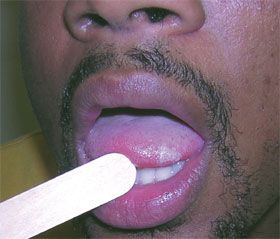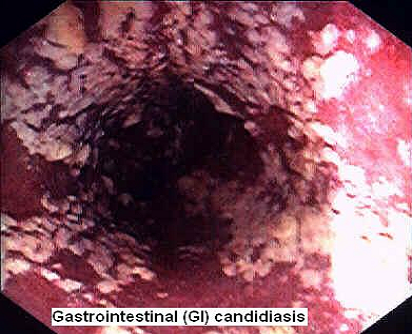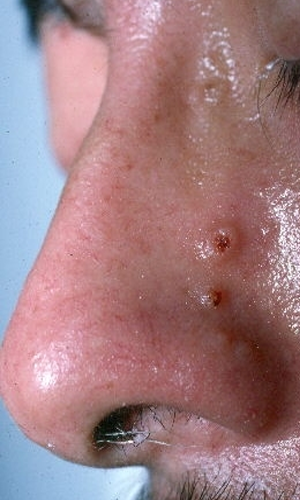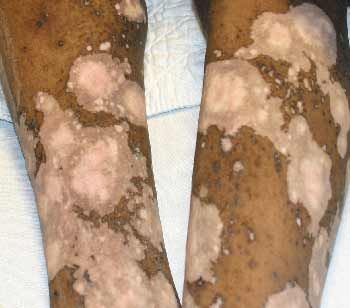HIV Lesions-A Photo Essay
Images: oral hairy leukoplakia, oroesophageal candidiasis, disseminated cryptococcosis, Stevens-Johnson syndrome, eosinophilic pustular folliculitis, prurigo nodularis.
A 30-year-old man with a 15 pack-year smoking history presented for a follow-up evaluation of an asymptomatic whitish lesion on the tongue that had not responded to oral therapy with nystatin or fluconazole. Multiple, nontender, whitish, vertical striations were noted along the right lateral edge of the lesion. A presumptive clinical diagnosis was made of oral hairy leukoplakia, the classic intraoral lesion of HIV/AIDS.

Image courtesy of James S. Studdiford III MD, Victor Diaz, MD, Amber Stonehouse Tully, MD,
and Danny Haddad, MD.
Click here for the next image
A 47-year-old HIV-positive man presented with severe thrush, profound dysphagia, and a 30-lb weight loss. He underwent an upper endoscopy with biopsies. Severe esophagitis was seen; biopsy specimens revealed unspeciated Candida. His advanced HIV disease made him vulnerable to the dramatic growth of Candida in his esophagus. He had oroesophageal candidiasis. Oral candidiasis is the most common fungal infection.

Image courtesy of Susan C. Ball, MD, MPH, MS.
Click here for the next image
A 38-year-old openly homosexual man presented with cough and multiple asymptomatic facial lesions. Physical examination showed many small, flesh-colored, umbilicated papules. Hospital screening labs revealed a positive HIV serology and gross lymphopenia. A skin biopsy of a facial papule confirmed disseminated cryptococcosis. Its cutaneous lesions may appear in a wide variety of morphologies.

Image courtesy of Ted Rosen, MD.
Click here for the next image
A 47-year-old woman who was seropositive for HIV-1 presented to the ED with severe maculopapular, erythematous eruptions. After a change in her antiviral regimen, she developed pruritus, difficulty in swallowing, fever, and painful ulcerations. Scattered target or iris lesions characteristic of erythema multiforme erupted on her trunk, extensor forearms, palms, and soles. Stevens-Johnson syndrome-a severe cutaneous hypersensitivity reaction-was the diagnosis even in the absence of cutaneous bullae. HIV-1-infected patients are at increased risk for severe mucocutaneous drug reactions.

Image courtesy of Dr Kamal Boulos, Dr H. Taha, and Dr Gamil Kostandy.
Click here for the next image
An HIV-positive, 48-year-old man presented with new-onset acne-like, pruritic lesions on his face. A biopsy specimen was obtained from his forehead. He had eosinophilic pustular folliculitis (EPF). The diagnosis may be difficult but often becomes clear after HIV infection has been diagnosed. EPF and other dermatological conditions often are a presenting clue to HIV infection in immunosuppressed patients.

Image courtesy of Paul Aanderud, DO, Chris Buatti, DO, and Kimball Silverton, DO.
Click here for the next image
A 38-year-old African American man with HIV infection presented with numerous dyspigmented macules and patches on the extremities, abdomen, and chest. Initially they were smooth, nontender, and minimally pruritic, but later the skin of his extremities and trunk became intensely pruritic. Pea-sized nodules developed in the areas of chronic scratching, and further itching and scratching led to the pigmentation changes shown here. Prurigo nodularis often occurs in immunocompromised patients, such as those with underlying disorders like HIV infection.

Image courtesy of Eric Parks, MD and Girendra Hoskere, MD.
Click here to return to the first image.